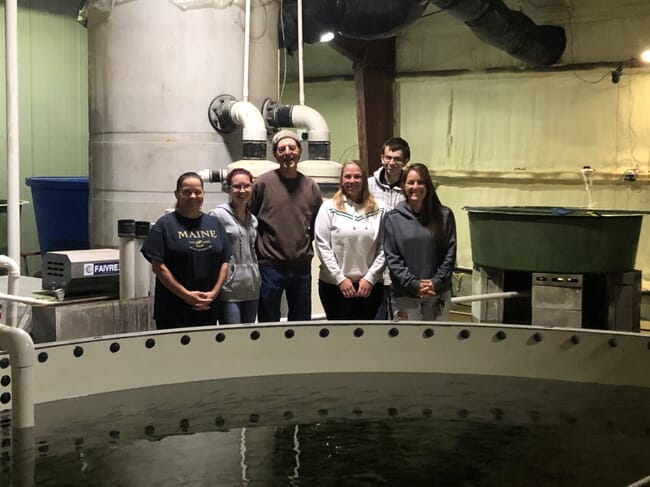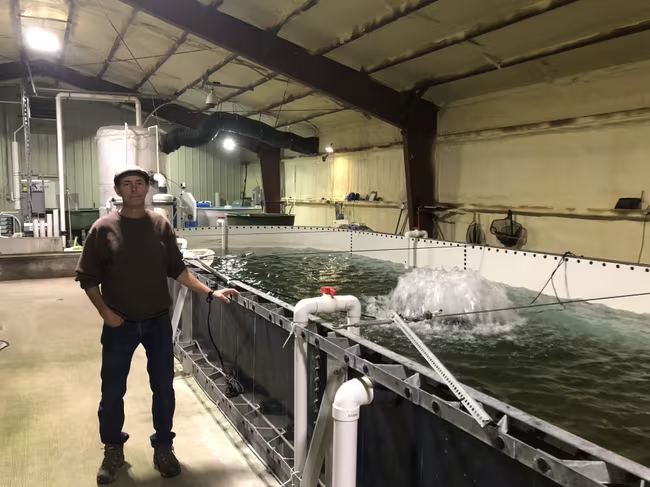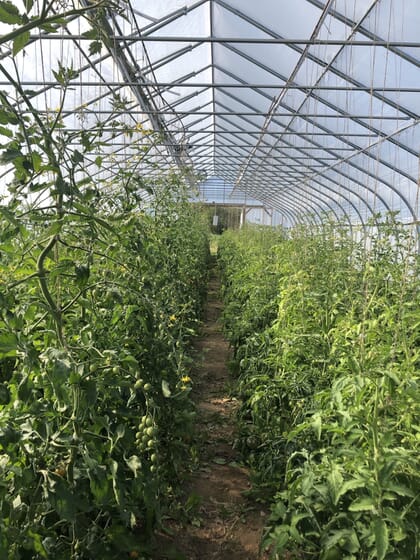
The Aroostook Band of Micmacs [Mik’maq] is a Native American tribe which historically called parts of Maine and the Canadian Maritimes home. They were not traditionally farmers, but hunters who moved with the seasons. In Aroostook county in Maine the population is sparse, with around 67,000 people inhabiting the largest American county by land area. Traditional jobs in more recent times were focused on the forestry and paper products industry. It’s an unlikely place for a cutting-edge recirculating aquaculture system (RAS).
Some years ago it was discovered that pond mortalities were on the rise for local populations of brook trout (Salvenlinus fontinalis). A culturally significant animal to the tribes and people of northern Maine, the fish was suffering from increased water temperatures, thought to be a result of climate change. Dave Macek, an environmental specialist working with the tribe, became involved with the effort to bring back brook trout here, and the tribe began a conservation effort initially designed to bolster a catch and release brook trout fishing industry. Not only have they been able to accomplish this goal by providing fish for stocking all over the state, but the effort has also resulted in a growing high-quality food that strengthens the entire community. They have used the latest in aquaculture technology to create a food fish which is in demand at retailers all over the region and helped to stabilise the food security of a remote region in the US.
Beginnings
The tribe was allowed to apply for, and received, a grant for funding the first steps in the project in 2010. They were supported by a grant from the US Fish and Wildlife Service, as well as the Federal Bureau of Indian Affairs. This allowed for construction of the large, hangar-like structure on the site of Micmac Farms location, on the border between Caribou and Presque Isle. The farm had been growing fruit and vegetables up to that point and selling them fresh or preserved and pickled.
Two mixed-cell raceway units are utilised in the facility where they grow brook trout. The fish can be seen swimming against the current in one cell within the raceway, while the fish a few inches away are feeling the effects of the next cell and are swimming in the exact opposite direction. At any time, there are somewhere in the neighbourhood of 45,000 fish within the system. About 12,000 pounds (5.4 tonnes) of fish per year is sold as food to local markets and retailers, or stocked in local ponds for anglers.
The facility uses no treatments in their water and has not had to use antibiotics with their animals. This small group has also cultivated a moving-bed biofilm reactor (MBBR) that has a longstanding, continuous colony of denitrifying biofilm that has been with the group since they started. A standard drum filter is employed and the system recycles somewhere in the order of 93 percent of the water it uses, and discharges only about 1,200 gallons per day.

Sustainability
The mindset of Micmac Farms is one of sustainability. As the aquaculture facility was incorporated into an already working farm, the opportunities to re-use the nutrients from the RAS are all around. The waste collected in the septic system and the drum filter then used to enrich the soil on their fallow fields. Fallow fields are planted with a cover crop that is generally a three species mix of buckwheat, field pea, patridge pea, or sunflower. These plants are good for pollinators and add in a significant amount of organic material to the soil.
Before they were known for their brook trout, Micmac farms was well known in the region for a rich selection of carefully grown produce; peppers, tomatoes, cucumbers squash and pumpkins to go along with a variety of pickled products such as fiddleheads, beets, green beans and cucumbers. They have some signature items as well including zucchini relish, a unique salsa, and chow-chow – a mix of green tomatoes, peppers, and onions that is salty, sweet, spicy and buttery all at the same time. Both the fish and the produce and bedding plants that are produced at the farm are sold to local or regional retailers. When visiting Aroostook County in Maine, it is difficult not to feel the vast distances from other townships and markets.
“Food security and food sovereignty are issues for everyone living this far north. Almost all of our food has to travel a long way. The work that we do here allows people to connect with what they eat and know where their food came from, how it was treated, and that it will be there day after day,” Macek explains. “By growing sustainable, local plants and fish we are strengthening the resilience of this region.”
Micmac Farms is also able to give away food to the local food bank and provides discounts for tribal members.
Training
Macek has been with Micmac Farms for over 22 years now. He has worked in environmental and air quality for the group. He is not a native of northern Maine, nor is he a tribal member. Nevertheless, his easy-going nature and love of his work are evident: “Growing up in Kansas City, my hobby was growing tropical fish in my basement. I didn’t set out to work in aquaculture, it just kind of happened this way.”
During the initial phases of the project, he was sent to Wyoming to participate in a 100-hour hatchery management course. That represents the total of formal, outside training for the people working at this facility. While the rest of the RAS industry and aquaculture in general grapples with the challenges of locating and hiring capable and knowledgeable staff, Micmac Farms has been able to foster a small nucleus of RAS capable individuals. Learning here has been accomplished over a number of years through experience and hard work.
During the first year of operations, the farm suffered a huge setback when a power outage caused the death of over 2,200 fish. The team had to procure a generator and create redundancy in their systems. They have experienced a CO2 spike in their tanks that led to odd fish behaviour. They didn’t have any mortalities but they were able to avoid any issues with baking soda and, eventually, with the introduction of an aeration system.
“We measure water quality constantly to ensure that the growing environment is clean and safe for the animals. The fish behaviour itself is very important to us. By being with the fish every day you can begin to understand what is normal and what is abnormal behavior,” Macek explains. “We have had issues, that’s the truth. We have learned from them, and it has taken five years to get things running as smoothly as they do today.”

High quality product
Once the trout are harvested, they are immediately processed and moved into cold storage and can reach retailers and customers the same day. Off-flavour has never been an issue. Fillets are light and fresh and demand a strong price in the marketplace. The animals do not undergo a purging period as seen in other RAS facilities, which Macek attributes to a couple of factors.
“Our groundwater is high quality Aroostook County ground water and is drinking water quality. The fish are gown in our constantly monitored, and constantly filtered, system and we use only the highest quality feed. We have never had the need to purge any of our animals.”
Due to the space available and volumes of the farm, fish cohorts destined for food markets are harvested over a longer period. The first fish to market may be 10” or so and the last fish from the group that are processed may be closer to 18”.
The future of the farm
Micmac Farms’ success with the combination of crop farming and RAS technology stems from a sustainability-orientated mindset. From the early beginnings as a pond-stocking operation to combat the effects of climate change, to the incremental training and learnings of the team, all phases have been done with a regional focus and an eye to increasing the resilience of the people and place around them. The people that work with the fish are local people who want to work with the land and farm, who have learned from experiences and trials. This has led to some discussion of expansion of the RAS operation, with the potential to triple their size in the coming years. The future is bright for the operation, which will continue to share its success with the tribe, the region and the environment.



